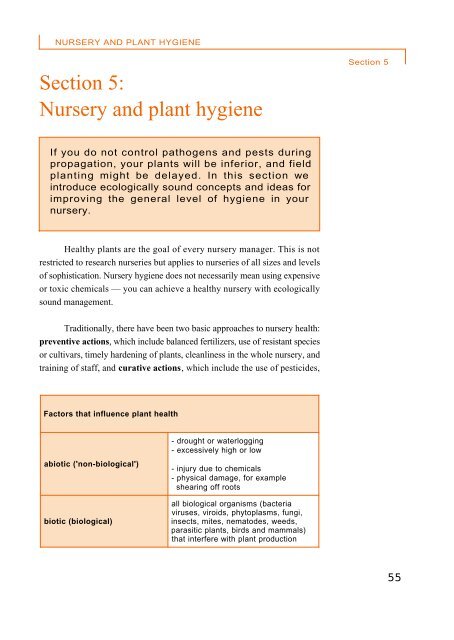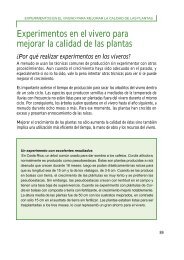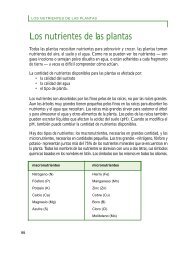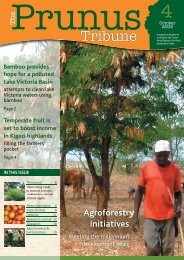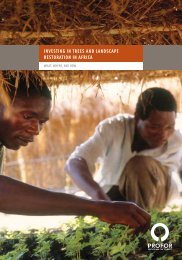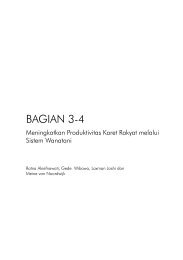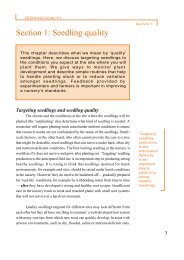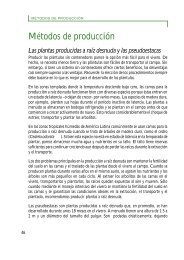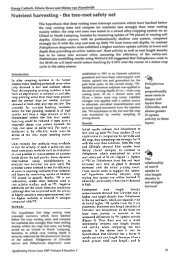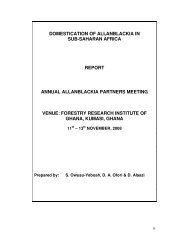Section 5: Nursery and plant hygiene - World Agroforestry Centre
Section 5: Nursery and plant hygiene - World Agroforestry Centre
Section 5: Nursery and plant hygiene - World Agroforestry Centre
You also want an ePaper? Increase the reach of your titles
YUMPU automatically turns print PDFs into web optimized ePapers that Google loves.
NURSERY AND PLANT HYGIENE<strong>Section</strong> 5:<strong>Nursery</strong> <strong>and</strong> <strong>plant</strong> <strong>hygiene</strong><strong>Section</strong> 5If you do not control pathogens <strong>and</strong> pests duringpropagation, your <strong>plant</strong>s will be inferior, <strong>and</strong> field<strong>plant</strong>ing might be delayed. In this section weintroduce ecologically sound concepts <strong>and</strong> ideas forimproving the general level of <strong>hygiene</strong> in yournursery.Healthy <strong>plant</strong>s are the goal of every nursery manager. This is notrestricted to research nurseries but applies to nurseries of all sizes <strong>and</strong> levelsof sophistication. <strong>Nursery</strong> <strong>hygiene</strong> does not necessarily mean using expensiveor toxic chemicals — you can achieve a healthy nursery with ecologicallysound management.Traditionally, there have been two basic approaches to nursery health:preventive actions, which include balanced fertilizers, use of resistant speciesor cultivars, timely hardening of <strong>plant</strong>s, cleanliness in the whole nursery, <strong>and</strong>training of staff, <strong>and</strong> curative actions, which include the use of pesticides,Factors that influence <strong>plant</strong> healthabiotic ('non-biological')biotic (biological)- drought or waterlogging- excessively high or low- injury due to chemicals- physical damage, for exampleshearing off rootsall biological organisms (bacteriaviruses, viroids, phytoplasms, fungi,insects, mites, nematodes, weeds,parasitic <strong>plant</strong>s, birds <strong>and</strong> mammals)that interfere with <strong>plant</strong> production55
NURSERY AND PLANT HYGIENE<strong>Section</strong> 5Thereare twoapproachesto nurseryhealth:preventiveactions <strong>and</strong>curativeactions.heat, biological control or physical measures (e.g. cutting out of diseased parts).From these two approaches, integrated pest management has evolved, combining‘preventive’ measures with ‘curative’ methods, <strong>and</strong> using chemical,biological <strong>and</strong> cultural control. It is neither practical nor wholly desirable toattempt total elimination of pests — many beneficial organisms are destroyedin such efforts, <strong>and</strong> a lack of beneficial organisms can lead to an explosiverecolonization of the nursery beds with pests.Actions to prevent nursery contaminationThere are five main entry points for pathogens into the nursery:• propagation facilities: containers, flats, knives, secateurs, workingsurface, boxes etc.Damping-offProbably the best-known nursery disease of all is damping-off, which is caused byseveral species of fungi, particularly Pythium, Rhizoctonia, Phytophthora <strong>and</strong> Fusarium.Damping-off can occur on seed beforegermination, or on young seedlings.When it happens, the stem of the seedlingbecomes constricted just above the surfaceof the germination substrate, <strong>and</strong> then theseedling falls over <strong>and</strong> dies. (Sometimes thiscan happen without any fungi present, forexample, with high temperatures of thepropagation medium.) There is often (but notalways) damage to the <strong>plant</strong> beneath the soilsurface as well. The reason for symptomsappearing at the soil surface are not wellunderstood but might be related to the pointwhere the <strong>plant</strong>s start photosynthesizing orwhere aerobic/anaerobic conditions areconducive to the more virulent stages of thelife cycle of the fungus.Pathogens which cause damping-off,particularly Pythium, Rhizoctonia <strong>and</strong>Phytophthora, can be spread in the irrigationwater. High <strong>plant</strong> density, overwatering <strong>and</strong>heavy shade favour the spread of the disease<strong>and</strong> should be avoided.56
NURSERY AND PLANT HYGIENE• propagation substrates• irrigation water• <strong>plant</strong>ing stock: seeds, cuttings, scions <strong>and</strong> rootstocks• shoes <strong>and</strong> clothing of nursery staff <strong>and</strong> visitors.Plant <strong>hygiene</strong> begins before propagation, by paying attention to these five entrypoints.Propagation facilities• Keep the nursery area itself free of weeds. Many <strong>plant</strong> species can bealternate hosts of important nursery pests. This precaution includes asensible selection of ornamentals, shade, hedge <strong>and</strong> windbreak <strong>plant</strong>s in<strong>and</strong> around the nursery, as they too can be hosts for pests such as nematodes.• Treat all wooden supports with old engine oil or chemicals against termiteattack. If possible, place propagation structures onto a slab of concrete.• Keep tools, work surfaces <strong>and</strong> containers clean at all times. Take particularcare with proper sterilization of containers, especially when these arereusable ones. Root diseases such as Fusarium root rot can be transmittedthrough diseased root segments grown into the wall of styrofoam containers.Some tools <strong>and</strong> containers can be autoclaved but the necessary equipmentis not always available.<strong>Section</strong> 5Keep thenurseryarea freeof weeds<strong>and</strong> keeptools, worksurfaces<strong>and</strong> containersclean atall times.One of the most satisfactory <strong>and</strong> readily available chemicals forsterilizing nursery equipment is chlorine, the active ingredient of householdbleach. Chlorine is a very irritating gas with a pungent odour. It evaporateseasily <strong>and</strong> its smell can be detected in very low concentrations (0.2–0.4 ppm);in higher concentrations it irritates eyes, nose <strong>and</strong> throat. It is a strong oxidizingagent <strong>and</strong> kills organisms by chemically ‘burning’ their tissue. It is usuallydiluted in water. The usual form of chlorine in household bleach is as the sodiumsalt, sodium hypochlorite (NaOCl). Commercial household bleach contains3.5% NaOCl in water. To use it as a sterilant, make a 10% solution (1 partbleach to 9 parts water) <strong>and</strong> soak instruments or containers in it for at least 30minutes. The use of a few drops of washing up liquid helps prevent air bubblesnext to the surface. Chlorine is deactivated by dirt particles. Therefore cleanall material to be sterilized thoroughly before putting it into the solution. Makea fresh solution each time you need it, <strong>and</strong> replace when dirty.57
NURSERY AND PLANT HYGIENE<strong>Section</strong> 5Use 10%householdbleach tosterilizetools <strong>and</strong>containers.Chlorine is a contact sterilizer <strong>and</strong> has no systemic functions. It canonly kill organisms that are exposed to it such as those suspended in the solutionor on the surface of the equipment. Therefore, it is a good idea to soak containers<strong>and</strong> other equipment in water for 24 hours before sterilizing so that fungalspores, for example, can germinate which makes them more susceptible to thetreatment. A 10% bleach solution is also used to sterilize bench surfaces <strong>and</strong>other work surfaces.The disposal of used chlorine solutions may be a problem: thehypochlorite ion attaches to organic compounds in the soil, can be taken up inthe food chain <strong>and</strong> can accumulate in the body fat of animals <strong>and</strong> humans. Thiscan pose a serious problem when large amounts of chlorinated water needs tobe disposed of. A practical solution for small amounts is to let a container withchlorinated water st<strong>and</strong> until it does not smell of chlorine any more.Note: As with any other chemical disinfectants, chlorine is a hazardoussubstance <strong>and</strong> misuse can lead to serious injury or even death. Use only inwell-ventilated areas.A less hazardous alternative to chlorine is hydrogen peroxide (H 2O 2),which breaks down to water <strong>and</strong> oxygen. Use 1 part commercial H 2O 2(35%)to 100 parts water. Other disinfectants frequently used, especially in thelaboratory, are formalin, mercuric chloride <strong>and</strong> 70% alcohol. These are allmore expensive than bleach, <strong>and</strong> in addition, formalin <strong>and</strong> mercuric chlorideare extremely poisonous <strong>and</strong> are suspected carcinogens.Propagation substratesWhen substrates, in particular soil <strong>and</strong> organic material, are broughtinto a nursery, they provide easy ways for pests to come too. In bare-rootnurseries or when practising open-ground propagation, pests may accumulatein the soil <strong>and</strong> make large-scale treatments or, in extreme cases, a move to anew location, necessary.The st<strong>and</strong>ard treatments for substrates are either chemical fumigationor sterilization with hot steam or sunlight. Chemical fumigation with methylbromide or related chemicals is very hazardous <strong>and</strong> expensive. Methyl bromide58
NURSERY AND PLANT HYGIENEis highly toxic to humans <strong>and</strong> it destroys the earth’s ozone layer. It is scheduledto be banned worldwide, although this ban will not be effective in most countriesuntil 2010. We therefore strongly discourage the use of methyl bromide.Environmentally safer options are sterilization (correctly called ‘pasteurization’because it is not a complete process) with either hot steam or sunlight(‘solarization’), or selective treatments with herbicides or fungicides ifnecessary.Substrates that have been manufactured using high temperatures, suchas vermiculite or perlite, do not need to be sterilized unless they are recycled.For storage of sterilized substrates, use only clean <strong>and</strong> disinfected containers.<strong>Section</strong> 5For storageof sterilizedsubstrates,use onlyclean <strong>and</strong>disinfectedcontainers.Soil pasteurization treatmentssteam pasteurizationSoil sterilization with aerated steam is preferred tofumigation with chemicals. However, steam is not selective<strong>and</strong> kills beneficial organisms as well as pathogens.Specialized equipment for steam pasteurization is notalways available. A practical <strong>and</strong> simple alternative can bemade using a clean oil drum: insert a strong mesh or grid atabout 1/3 its height from the bottom, for example by weldingiron rods at close spacing. Put the drum onto stone feet, fillwith water up to the grid <strong>and</strong> place the substrate in sacks ontop of the grid. Cover the drum, light a fire under the drum<strong>and</strong> keep burning for 2–4 hours. Ensure that thetemperature of the substrate reaches 60°C for 30 minutes.This will kill most <strong>plant</strong> pathogenic fungi <strong>and</strong> bacteria, aswell as nematodes, but only a few viruses, <strong>plant</strong> insects orweed seeds. If you need a more complete treatment, raisethe temperature to 80°C <strong>and</strong> hold this for 30 minutes.However, at this temperature, so many beneficial organismswill be killed that this may lead to an explosive recolonizationof the substrate with pathogens.solarizationSolarization can be carried out in any nursery. Cover moist soil with transparentpolyethylene sheets <strong>and</strong> weigh them down with rocks. On sunny days, the temperatureunder the plastic sheet will reach 70°C or more. However, this pasteurization affectsonly the first few centimetres of soil <strong>and</strong> under cloudy conditions it can take severalweeks for a successful treatment.59
NURSERY AND PLANT HYGIENE<strong>Section</strong> 5A smallamount ofchlorine toprovide a 1ppm concentrationfor atleast 30minutes canbe added tothe irrigationwater tocontrol damping-offfungi.Irrigation waterWater for irrigating in nurseries often comes from a dam, a borehole ora tank filled with rain water. These stagnant reservoirs provide excellentconditions for water mould fungi — species of Pythium <strong>and</strong> Phytophthora —which are commonly associated with damping-off. A small amount of chlorineto provide a 1 ppm concentration for at least 30 minutes can be added to theirrigation water to control damping-off fungi. (Swimming pool water has amaximum concentration of 8 ppm available chlorine).Disinfecting irrigation waterHousehold bleach usually has a strength of 3.5% or 35 000 ppmNaOCl. It contains 24 000 ppm chlorine (Cl 2). To make 1 L of a1 ppm Cl 2dilution, 0.042 ml (or 42µl) of household bleach isneeded. For a 20 L bucket, 20 x 0.042 = 0.84 ml. A 10 000 litrewater tank would need 420 ml. If the water contains a lot ofsediment or other dirt particles, up to twice as much will beneeded. In any case, the amount needed for treating irrigationwater to check diseases like damping-off is very small, <strong>and</strong> thismakes nursery <strong>hygiene</strong> affordable <strong>and</strong> simple.Diseased<strong>plant</strong>s ina nurseryshould beculled rigorously<strong>and</strong> burntratherthancomposted.Planting stockPlant material from other nurseries (seed, cuttings, scion wood <strong>and</strong>rootstock) can harbour nursery pests. Wherever possible, accept propagationmaterial from nurseries only if it has a <strong>plant</strong> inspection certificate. If in doubt,surface sterilization should be carried out on all new <strong>and</strong> unknown material.Diseased <strong>plant</strong>s in a nursery should be culled rigorously <strong>and</strong> burnt ratherthan composted. Composting diseased material can only be recommended ifthe compost temperatures are high enough to kill pests (above 60°C), <strong>and</strong> canbe maintained at this level for several days.Shoes <strong>and</strong> clothingQuite often, diseases are brought into a nursery inadvertently on shoes(soil-borne diseases <strong>and</strong> nematodes) or clothing (weed seeds). This is very60
NURSERY AND PLANT HYGIENEdifficult to control. The best way is probably to issue to staff boots <strong>and</strong> workclothes to wear during work in the nursery <strong>and</strong> to install a dip basin with 10%household bleach solution at the entrance of the nursery through which staff<strong>and</strong> visitors have to walk to disinfect their shoes, especially when they comefrom fields where soil-borne diseases or nematodes are present.<strong>Section</strong> 5Methods ofsurface sterilizationheatchlorinefungicidesFor seeds, tubers <strong>and</strong> roots, hot water soaks(40–55°C) are recommended. Temperature <strong>and</strong>duration depend on the species. You can find thebest range with simple experimenting, forexample by soaking material at two differenttemperatures for half an hour, two hours <strong>and</strong> fourhours.Dipping cuttings into a 10% household bleachsolution for 20 minutes is a practicerecommended for some hardwoods but it shouldbe tested for phytotoxicity on all species first.Seeds or cuttings can be coated with a dust orslurry of fungicides. Captan ® <strong>and</strong> Benlate ® arethe most commonly used fungicides for seedtreatment. Captan ® is a contact fungicide whichkills pathogens present on the seed coat;Benlate ® is a systemic fungicide whichpenetrates into the seed <strong>and</strong> has an effect on theembryo during germination, giving the seed alonger-lasting protection. However, mostfungicides have a high toxicity to seeds <strong>and</strong> theyoften act only on one of the number ofpathogensthat are usually present. Recent work suggeststhat coating the seed with a bacterialformulation, esp. Trichoderma harzianum orPseudomonas spp., would be helpful. However,for the time being, this technique is out of reachfor most institutions in developing countries.61
NURSERY AND PLANT HYGIENEActions to preventnursery contamination<strong>plant</strong> health status<strong>plant</strong> densityhardeningresistant speciesor cultivarscleanliness invegetative propagationstaff trainingHealthy, well-fertilized <strong>and</strong> properly irrigated <strong>plant</strong>s arebetter suited to withst<strong>and</strong> pest attacks. However, overfertilizingshould be avoided, especially excess nitrogen,which weakens <strong>plant</strong>s <strong>and</strong> makes them more attractiveto many sap-sucking insects, such as aphids <strong>and</strong>psyllids.Avoid very dense spacing in germination <strong>and</strong> nurserybeds, because diseases can spread easily. Closespacing can also lead to etiolated <strong>and</strong> weak <strong>plant</strong>swhich are susceptible to disease.Timely hardening of seedlings will produce strong <strong>and</strong>healthy <strong>plant</strong>s that are able to withst<strong>and</strong> a certainamount of pest or disease attack.If possible, grow resistant types or cultivars, or avoidsusceptible species altogether. For example, citrusshould not be propagated in areas with high incidenceof aphids, since aphids transmit citrus greening disease,<strong>and</strong> spraying against the aphids usually cannot checkthe problem to the necessary extent.When harvesting scionwood <strong>and</strong> cuttings, take care thatthey come from healthy stock <strong>plant</strong>s that are notdepleted of nutrients or drought stressed, to enhancetheir resilience to diseases. Always sterilize knives <strong>and</strong>secateurs with alcohol to avoid spreading virusdiseases, which are often transmitted on the tools.To keep pest <strong>and</strong> disease levels low, all employeesshould be trained to recognize <strong>and</strong> report pests.Workers who are in daily close contact with the <strong>plant</strong>sthrough watering, weeding etc., will probably more oftenencounter such problems than a nursery managerwould.62<strong>Section</strong> 5
NURSERY AND PLANT HYGIENEActions to cure infected <strong>plant</strong>sIn instances of pest or disease attack, you will have to decide whether touse physical, biological or chemical pest management.In areas where manual labour is readily available, <strong>and</strong> when the incidenceis not very severe, collecting of pests or diseased leaves from the seedlings byh<strong>and</strong> <strong>and</strong> destroying them may be practical. Biological agents such as parasiticwasps can be used but they are not available everywhere. Successful studieswith various agroforestry tree species, such as Gliricida sepium, Erythrinaspp., Calli<strong>and</strong>ra calothyrsus <strong>and</strong> Leucaena leucocephala have been carriedout by the Institute of Biological Control, the International <strong>Centre</strong> for InsectPhysiology <strong>and</strong> Ecology <strong>and</strong> other institutions which can provide moreinformation.However desirable the use of biological methods, chemical sprays ordrenches are still in most cases the methods of choice. These pesticides actquickly, <strong>and</strong> often they are selective so they do not destroy beneficial organisms.For important horticultural crops in temperate zones, pest occurrence thresholdshave been published, below which the use of pesticides is not recommended.For tropical trees, notably agroforestry tree species, no such thresholds exist.We recommend that nursery managers develop them for their local conditions.For example, you could decide to spray with an insecticide against aphids onlyif these are detected on more than half of the stock, or to use a miticide againstspider mites only if more than 10% of <strong>plant</strong>s show symptoms. Of course thesethresholds depend on the species <strong>and</strong> their susceptibility to the pests, <strong>and</strong>developing them requires intimate knowledge of the species.<strong>Section</strong> 5In areaswheremanuallabour isreadilyavailable,<strong>and</strong> whentheincidenceis not verysevere,collectingof pests ordiseasedleaves fromthe seedlingsby h<strong>and</strong> <strong>and</strong>destroyingthem maybe practical.63
NURSERY AND PLANT HYGIENE<strong>Section</strong> 5Further readingEvans J. 1982. Plantation forestry in the tropics. Oxford Science Publications.Oxford, UK: Oxford University Press. 472 pp.Hartmann HT, Kester DE, Davies FT <strong>and</strong> Geneve RL. 1997. Plant propagation.Principles <strong>and</strong> practices. Sixth edition. London. UK: Prentice HallInternational. 770 pp.L<strong>and</strong>is TD. 1994. Using chlorine to prevent nursery diseases. Forest <strong>Nursery</strong>Notes 7-94. (source: http://willow.ncfes.umn.edu/fnn_7-94/ipm794.htm)L<strong>and</strong>is TD, Tinus RW, McDonald SE <strong>and</strong> Barnett JP. 1989. The BiologicalComponent: <strong>Nursery</strong> pests <strong>and</strong> mycorrhizae. vol. 5, The container tree nurserymanual. Agriculture H<strong>and</strong>book 674. Washington, DC, USA: US Departmentof Agriculture, Forest Service. 171 pp.Schauer T. 1996. Methyl bromide: an international inconsistency? In http://www.brobeck.com/docs/methyl.htm. Brobeck, Phleger <strong>and</strong> Harrisonenvironmental law practice.Sing Rathore, MP. 1995. Insect pests in agroforestry. ICRAF Working Paperno. 70. Nairobi, Kenya: ICRAF. 73 pp.64


